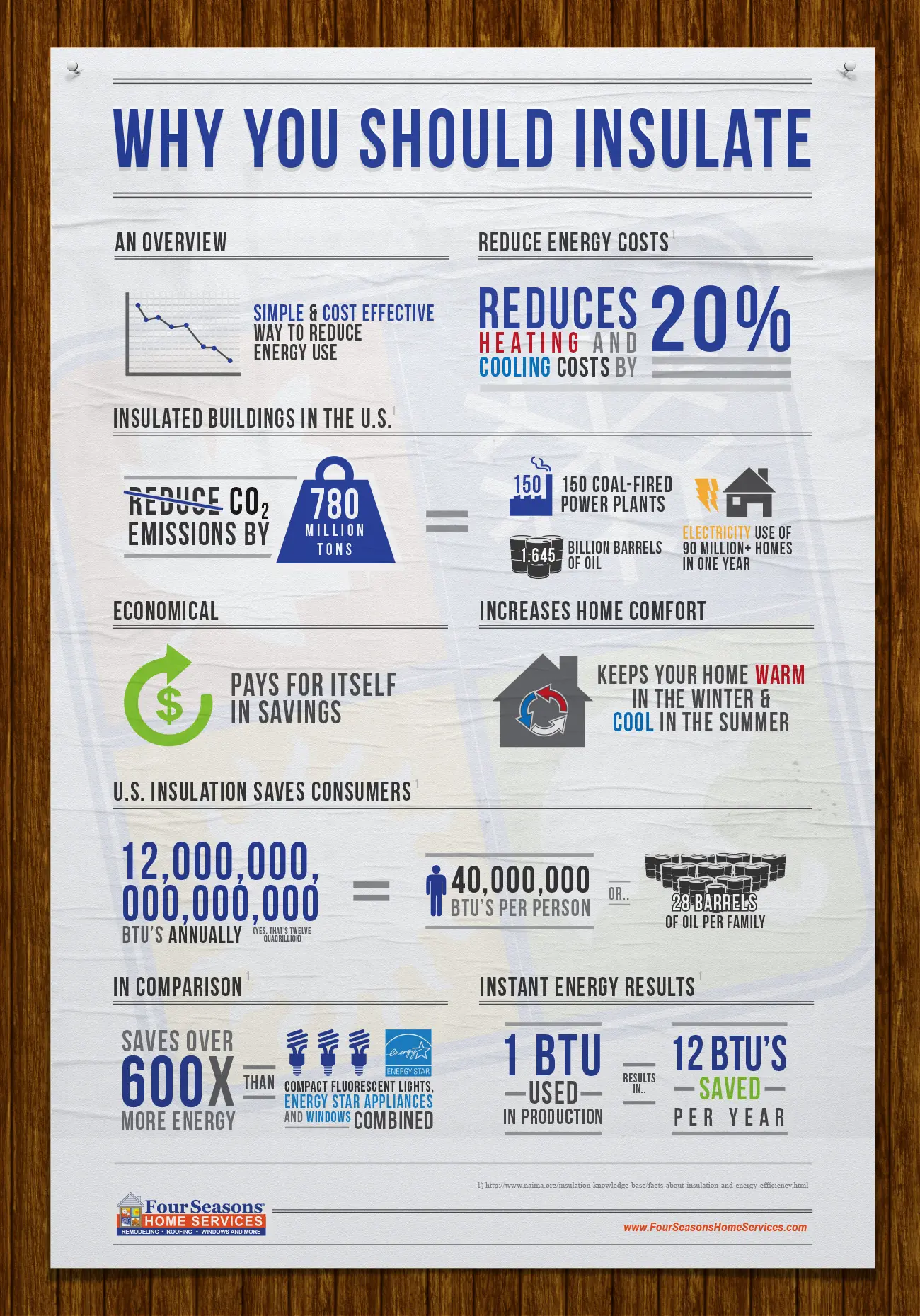When you think of insulation, the color pink probably comes to mind. But as it turns out, insulation can be green, as in earth-friendly, too! Most homeowners leave the decision of insulation to contractors. After all, insulation isn’t exactly designed with aesthetics in mind. But a new wave of eco-friendly insulation options has arrived, and they’re more than worth exploring for your green building or remodeling project.
Insulation is designed to reduce energy costs, so in that sense, any insulation could technically be considered green. But eco-friendliness comes down to so much more than that – the manufacturing process, materials, and toxicity are other highly important factors to consider.
Fiberglass insulation, a.k.a. “the pink stuff,” may be the cheapest option, but it’s far from the most eco-friendly. The making of fiberglass insulation is an energy-intensive process — up to 10 times more so than eco-friendly alternatives. Even more, fiberglass insulation contains hazardous fibers that are linked to health issues like skin, eye, and respiratory tract irritation. And while fiberglass insulation can contain up to 30 percent recycled glass, it’s no match for the impressive 80 percent recycled content that some insulation options can offer.
For something with such a simple concept, insulation comes with a huge variety of options. But have no fear, our complete eco-friendly insulation guide is here! Read on for everything you need to know about green insulation benefits, R-values, and your eco-friendly insulation options.
First, Why is Insulation so Important?
To understand why insulation is important, we need to understand thermodynamics. It sounds complex but it’s pretty simple. Basically, it tells us that heat moves from areas of high temperature to low temperature. And the age-old saying that heat rises? It’s true, but not always. Heat can move all sorts of directions; a difference in temperature is what drives heat to move up, down, or sideways.
Another factor in the movement of air is density. In the winter, warm, low-density air inside a home will move up and out into the dense, cold air outside. During the summer, warm, low-density air from outside moves inside a home from the top and sinks to the bottom, while the cool, dense air inside leaks outside through the bottom of a home.
If houses could be 100 percent sealed, air movement would work a lot differently. But even with the best insulation out there, air will still find ways to invite itself in, and see itself out.
The point of insulation is to combat the movement of air. And since air can move in all sorts of directions, insulation is needed in roofs, ceilings, walls, and floors to prevent air from entering and leaving.
Insulation is one of the most important factors that contribute to a home’s energy efficiency – or inefficiency. With improper insulation, a homeowner spends more on heating and cooling, which uses more resources to run, and costs more money.
The US Department of Energy estimates that 44 percent of the energy use in American homes goes toward heating and cooling. Read on to find out how eco-friendly insulation options can lower your energy bills, reduce energy use, and lower your greenhouse gas emissions.

How is insulation measured?
Insulation effectiveness is measured by its thermal resistance value, or R-value, a number between 1 and 60 that reflects the material’s resistance to heat transfer. The better the insulation, the higher the R-value. This number is determined by the type of insulation, its thickness, density, and where and how the insulation is installed.
So how much insulation will you need? Every situation is unique, but typically the cooler your climate, the higher the R-value you’ll need. The climate, type of heating and cooling systems installed, and the area of your home you want to insulate all affect the R-value needed.
Eco-Friendly Insulation Benefits
Safe and Sustainable Materials
Natural, formaldehyde-free materials make eco-friendly insulation products the best choice for a green and healthy home. Unlike fiberglass, insulation materials like wool and cotton are safe to handle and cause no irritation to the skin or respiratory tract. And choosing insulation with recycled materials reduces your carbon footprint, since you’re investing in a product that makes use of content that would otherwise be sent to a landfill.
Lower Manufacturing Costs
Insulation options like wool, shredded denim, and cork require minuscule amounts of energy to produce in comparison to fiberglass insulation. It actually takes 10 times more energy to produce fiberglass insulation than cellulose insulation. Saving energy during production means a reduction in harmful greenhouse gases.
Energy Cost Savings
True, it’s possible to achieve the recommended insulation factor (R-value) using fiberglass insulation. And as we mentioned, any insulation manufacturer could make an eco-friendly claim based on the reduction in energy costs that insulation is designed to provide. But these green alternatives aren’t just safer and more sustainable — they can often provide much better insulation per square inch. The spray foam insulation known as Icynene, for example, can reduce a home’s energy bill by 30 to 50 percent!
Types of Eco-Friendly Insulation
Sheep’s Wool
You’ve heard of using sheep’s wool in clothing and blankets to keep us warm – but what about in our walls and ceilings? The plush yet fire-resistant material works just in our homes as it does on a sheep. Compressed wool fibers form air pockets that trap air to keep us cool in the summer and warm in the winter. The breathable material’s inner layers absorb moisture without feeling damp or affecting its ability to retain heat. Because of wool’s properties, you don’t need to constantly adjust your heating and cooling systems, which saves energy and money.
Aerogel
Eco-friendly doesn’t always mean naturally occurring. In 1931, Samuel Stephens Kistler invented aerogel, a material that is comprised of more than 90 percent air. It’s made by removing the liquid from silica under high pressure and temperature. You can buy aerogel in sheets or stickers that make it easy to apply. The ultra lightweight material can cost up to $2 a foot but will save you money on heating and cooling costs.
Denim
The cotton plant is both natural and renewable, making it incredibly eco-friendly. But denim in your walls? No, there aren’t stacks of jeans inside the walls, the material is rolled into batts like fiberglass. But unlike fiberglass, cotton doesn’t contain the dangerous gas formaldehyde. Furthermore, cotton doesn’t cause respiratory problems and it’s also an insect repellent! Cotton insulation does come with a hefty price tag (twice as much as fiberglass) but think of all the jeans you’re saving from a landfill.
ThermaCork
ThermaCork is a product made from the outer bark of oak trees and is natural, renewable, recyclable, and biodegradable. Once produced, the finished product actually has a negative carbon footprint. Cork reduces energy consumption and will continue to do so far longer than most insulation choices. It’s also hypoallergic, free of domestic toxins, and works to mute sounds.
Polystyrene
Polystyrene is actually a type of plastic. And although plastic is not traditionally green, it’s considered to be in this instance because the R-values are so high that it ends up saving a lot of energy. It can come in both a foam board (which adds structural integrity to walls) or a spray foam.
Cellulose
This insulation is made of recycled newsprint and other types of paper that otherwise would have decomposed in a landfill, releasing harmful greenhouse gases. If all the paper put into landfills each year was converted to cellulose insulation, it would save eight million tons of CO2 emissions, which is like taking every car off the road in both Nevada and New Mexico! Cellulose is one of the safest types to install and is a good choice for those looking to minimize the toxins in their home.
Icynene
Included in a list somewhere of “101 Things To Do With Castor Oil” is insulating your home! Icynene is made from castor oil and is a spray foam insulation that expands almost 100 times its volume when sprayed onto a surface. The material is not only great at sealing leaks and drafts, but it also works to help cancel noise. Because its sealing powers are so strong, a ventilation system needs to be installed – and if you live in a cold climate, the ventilation system also needs an air exchanger. Icynene costs three times as much as fiberglass and with the additional systems required, the upfront costs are expensive. But this powerful insulation can reduce energy bills by 30 to 50 percent – saving you money in the long run.
Conclusion?
There’s no right choice when it comes to insulation. Each situation is unique and it’s important to consider all the facts when deciding what material is right for you and your home. Make a list of qualities you want most from your insulation and list them in order of importance. When you narrow down some materials that fit your needs, make a list of pros and cons for each option and you’ll discover what choice is best for you.
Want more information about eco-friendly insulation? Check out:
- Energy Efficiency: What’s the Difference Between Thermal Mass and Insulation R-Value?
- 10 Eco Building Materials Revolutionizing Home Construction
- Insulation 101: A Net-Zero Builder’s Formula for Insulating a Super Energy-Efficient Home


